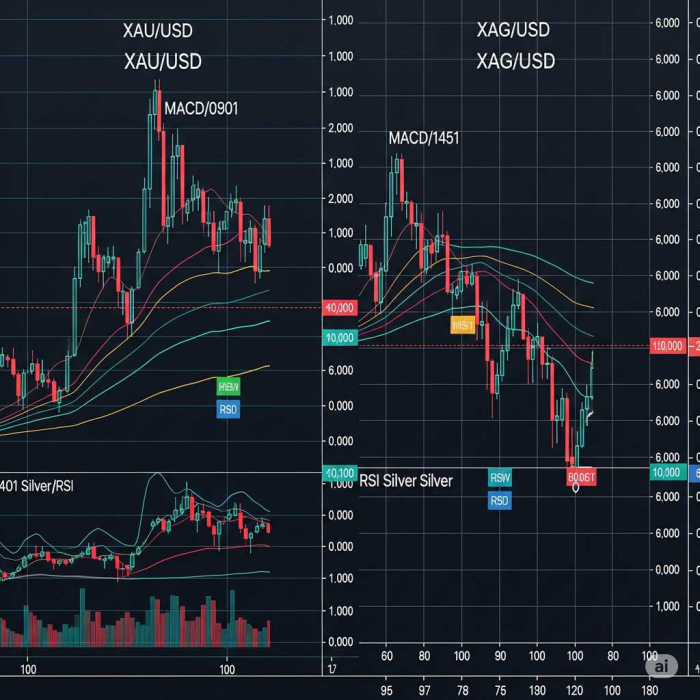Unearthing Opportunity | A Deep Dive into Gold (XAU/USD) and Silver (XAG/USD) Trading
Gold (XAU/USD) and Silver (XAG/USD) have captivated investors for centuries, not just as symbols of wealth but as dynamic trading instruments. In the volatile landscape of global finance, these precious metals often shine as safe havens, offering unique opportunities for diversification and profit. But what exactly makes them tick, and how can traders navigate their nuanced movements?

The Enduring Allure of Precious Metals
Gold and silver, often referred to as "safe-haven" assets, tend to hold or even increase their value during times of economic uncertainty, geopolitical tensions, and inflation. Unlike fiat currencies, they cannot be printed at will by central banks, giving them intrinsic value. This makes them attractive hedges against currency devaluation and market downturns.
Why Gold (XAU/USD) Continues to Gleam:
Gold, traded as XAU/USD against the US Dollar, is the ultimate safe-haven. Its price is heavily influenced by:
- Economic Uncertainty and Inflation: When inflation rises or economic instability increases, investors flock to gold to preserve their wealth. Recent years have seen gold reach record highs, driven by persistent global inflation and the ongoing demand from central banks.
- Central Bank Demand: Many central banks, particularly in emerging economies, have been aggressively increasing their gold reserves, further bolstering demand.
- Geopolitical Tensions: Conflicts and political instability worldwide often send investors seeking refuge in gold, driving its price upward.
- US Dollar Strength: Since gold is priced in USD, a weaker dollar generally makes gold more affordable for international buyers, increasing demand and pushing prices higher.
Silver (XAG/USD): More Than Just Gold's Younger Sibling:
Silver, traded as XAG/USD, shares many of gold's safe-haven qualities but also possesses a significant industrial demand component. This dual nature can make its price movements more volatile and, at times, more unpredictable.
- Industrial Demand: A substantial portion of silver's supply is used in various industries, including electronics, solar panels, and electric vehicles. This makes silver's price susceptible to economic booms and busts; strong industrial growth often correlates with higher silver prices.
- Volatility: Silver's lower price per ounce compared to gold, combined with its industrial demand, often leads to greater percentage price swings. While this presents higher risk, it also offers potentially larger returns for agile traders.
- Gold-Silver Ratio: Traders often observe the gold-silver ratio (gold price divided by silver price) for insights. A declining ratio can suggest a shift in investor preference towards silver, indicating potential outperformance.
Strategies for Trading Gold and Silver
Successfully trading XAU/USD and XAG/USD requires a blend of technical analysis, fundamental understanding, and robust risk management.
Key Trading Strategies:
- Trend Following: Identifying and trading in the direction of the prevailing price trend is a popular approach. Moving averages and other trend indicators can help spot upward or downward trends.
- Range Trading: When gold or silver prices consolidate within a defined range, traders can buy near support levels and sell near resistance levels. Oscillators like the Relative Strength Index (RSI) can signal overbought or oversold conditions within the range.
- Breakout Trading: This strategy involves waiting for prices to break above key resistance or below key support levels, indicating a potential new trend. Volume confirmation is crucial for validating breakouts.
- News Trading: Economic data releases (e.g., inflation reports, interest rate decisions, employment figures) and major geopolitical events can significantly impact precious metal prices. Traders monitor these announcements to capitalize on post-news volatility.
- Gold-Silver Ratio Trading (Pairs Trading): Some advanced traders use the gold-silver ratio to identify imbalances. If the ratio is historically high, they might go long on silver and short on gold, expecting the gap to narrow.
Essential Considerations for Traders:
- Risk Management: Precious metals, especially silver, can be volatile. Always use stop-loss orders to limit potential losses. Never risk more than you are prepared to lose on any single trade.
- Liquidity: Gold and silver are highly liquid assets, meaning they can be easily bought and sold. This ensures tight spreads and efficient execution.
- Leverage: Forex brokers offer leverage for trading XAU/USD and XAG/USD, which can amplify both profits and losses. Use leverage wisely and understand its implications.
- Economic Calendar: Stay informed about global economic indicators and central bank policies, as these are major drivers of precious metal prices.
- Technical Analysis Tools: Utilize charting software and technical indicators (MACD, RSI, Fibonacci retracements, support/resistance levels) to identify entry and exit points.
The Risks Involved
While lucrative, trading gold and silver is not without its risks:
- Price Volatility: While offering profit opportunities, sudden and significant price swings can lead to substantial losses if not managed effectively.
- Currency Risk: As XAU/USD and XAG/USD are priced in USD, fluctuations in the US dollar's value can impact your positions, especially if your base currency is different.
- Storage and Insurance Costs (for physical metals): If you opt for physical ownership, consider the costs associated with secure storage and insurance. CFD trading, which allows speculation on price movements without physical ownership, bypasses these costs.
- Market Sentiment: Trader sentiment and speculative activities can also contribute to price volatility.
Conclusion
Trading gold (XAU/USD) and silver (XAG/USD) offers compelling opportunities for traders seeking to diversify their portfolios and capitalize on market movements driven by global economic conditions and geopolitical events. By understanding the unique characteristics of each metal, employing sound trading strategies, and prioritizing robust risk management, traders can navigate these dynamic markets and unearth potential profits. However, as with any financial endeavor, thorough research, continuous learning, and a disciplined approach are paramount to success.
Popular Tags